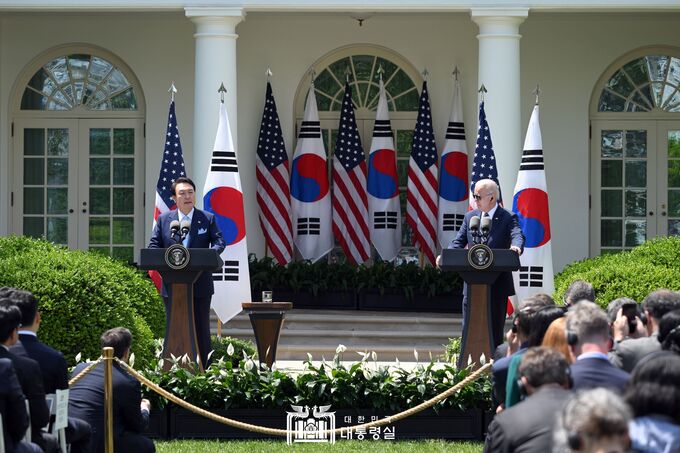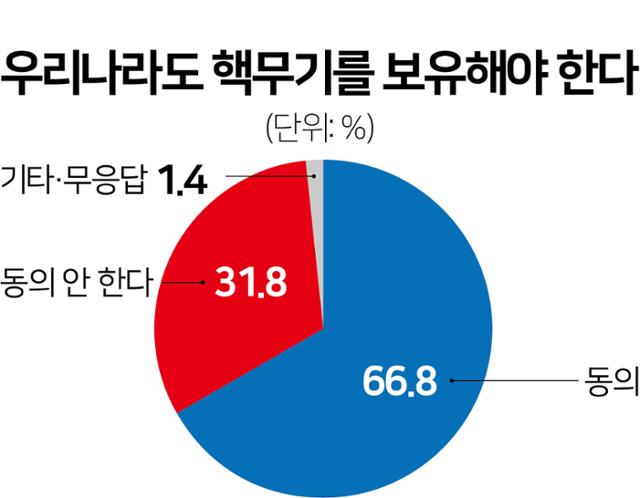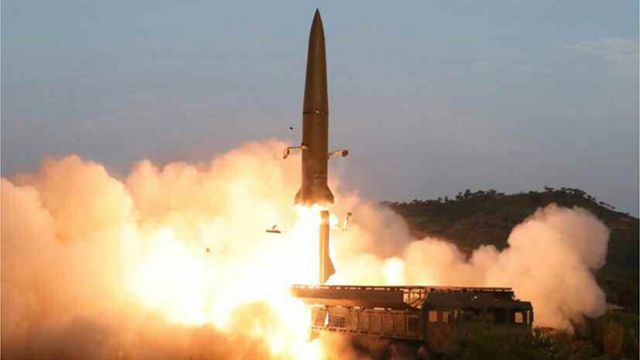“South Korea and the Nuclear Puzzle: Is
Self-Nuclear Armament the Answer?”
“Of course, if the problem becomes more serious, we may deploy tactical nuclear weapons here in Korea, or we may have our own nuclear weapons.”
On January 11,
President Yoon Seok-Yeol’s remarks reignited the debate about the nuclear
armament of Korea. Although the Washington Declaration has strengthened South
Korea’s ability to protect itself, its evaluation was divided between experts
and the general public. For experts, it was hailed as the best agreement,
yet the public criticized the concession as a hurdle in the way of
self-nuclear armament. It is evident that aspirations for self-nuclear
armament remain in Korean society. Thus, in this column, The Sogang Herald
will examine the Washington Declaration, the history and meaning of
self-nuclear armament, and the necessity and possibility of self-nuclear
armament through a multi-faceted analysis.
What is
Self-Nuclear Armament?
Self-nuclear
armament refers to acquiring the ability to deploy nuclear weapons without
depending on a foreign nation such as the United States of America. South Korea
has made several attempts at nuclear armament in the past. Under the Park
Chung-hee administration, the country established the Arms Development
Committee and the Defense Science Research Institute. South Korea acquired
nuclear-reprocessing technology from France, imported heavy water reactors from
Canada, and obtained missile technology from the United States. With the
fundamental requirement of nuclear development met, only the development phase
was left for South Korea to achieve nuclear armament. However, the fear of the US
pressure and sanctions led to the termination of nuclear development in 1976.
During the new military administration led by Chun Doo-hwan, a nuclear
development plan utilizing plutonium, a radioactive material used to produce
nuclear weapons, was promoted in 1982, extracting a significant amount of
plutonium. Yet when the United States government became aware of these
activities, Chun Doo-hwan was forced to abandon the nuclear program in
1983.
Even after the
civilian government took office, South Korea clandestinely conducted
experiments related to uranium conversion, enrichment, and plutonium separation
until the 21st century. However, these activities were
halted once again due to special inspections by the International Atomic Energy
Agency. Subsequently, there were no significant developments until the Yoon
Seok-yeol administration, which sparked heated debates on self-nuclear armament
until official remarks regarding the conditional self-development of nuclear
weapons were made. The discussions continued until the Washington Declaration
was presented to the public.
This Washington
Declaration was also one of America’s acts for quelling Korea’s aspirations for
nuclear armament. The Washington Declaration gives South Korea a central role
in the strategic planning for the use of nuclear weapons in any conflict with
North Korea. In return, South Korea agreed not to pursue its own nuclear
arsenal.
 ©Office
of the President of the Republic of Korea
©Office
of the President of the Republic of Korea
Views on the
Washington Declaration are divided, with some reacting positively to a more
conventional weapons arrangement and more influence on America’s nuclear
weapons. However, others criticize the move as it completely abandons the
option to develop and possess Korea’s own nuclear arsenal. One expert argues
that the US-ROK Nuclear Consultative Group is the best choice for the United
States, concerned about the domino effect leading to nuclear proliferation, and
the Korean government, seeking to secure extended deterrence. He emphasizes the
importance of constantly exerting Korea’s influence on America’s nuclear weapon
control by implementing the NCG.
On the other hand,
experts on the other side argue that the Washington Declaration is the complete
waving of the right to withdraw from the Nuclear Non-Proliferation Treaty(NPT).
Also, they are suspicious about the faithful implementation of the declaration
under a radical right-wing government, citing the example of President Trump.
Furthermore, they point out that the Korean government fails to revise the
Korea-US Nuclear Agreement, which imposes stringent conditions on spent nuclear
fuel reprocessing and uranium enrichment compared to the US-Japan Nuclear
Agreement. So far, we’ve looked at the self-nuclear armament itself and Korea’s
failed attempts. At this point, this column intends to pose a question. “Do the
Koreans really think that the self-nuclear armament is required?”
“Does the Korean
Public Want a Nuclear Arsenal?”
In some surveys,
it seems that there are aspirations for self-nuclear armament among Koreans.
According to Gallup Korea surveys conducted in the 2010s, approximately 50-60%
of the public expressed support for nuclear development. More than half of the
population holds a favorable view of the concept of nuclear armament. According
to the Hankook Ilbo/Hankook Research New Year’s opinion poll, 66.8% of
respondents (34.0% strongly agree, 32.8% generally agree) agreed with the claim
that South Korea should possess nuclear weapons. In contrast, only 31.8%
disagreed with this claim. Across different ideological affiliations, more than
half of liberals (54.4%), moderates (70.7%), and conservatives (69.5%) agreed
with the idea of South Korea possessing nuclear weapons. When asked about the
United States' stance in the event of a military clash between the two Koreas,
only 36.7% of respondents believed that the United States would unconditionally
support South Korea. A more significant portion (53.6%) thought the United
States may or may not intervene based on self-interests. Some respondents even
suggested that the United States might not intervene due to concerns about
burden-sharing (4.1%). Despite the 70-year history of the ROK-US alliance,
there is an underlying consciousness that blind trust and reliance on the
United States may not be advisable in emergency situations.

©Hankookilbo
However, the 2023 Asan Institute for Policy Studies survey revealed some important points. When the possibility of sanctions was not mentioned, 64.3% agreed, and 33.3% disagreed with self-nuclear armament. But, when the possibility of sanctions was introduced, the percentage of agreement decreased to 54.7%—simply mentioning the possibility of sanctions led to a decrease of about 10% in support. It can be inferred that the lack of accurate information about international sanctions and potential risks might contribute to the public’s support of the self-nuclear armament process. Also, from a political psychology paper that focused on the relationship between Korean’s opinion about self-nuclear armament and knowledge about the consequences that Korea will face if the self-nuclear armament happens, 58% of participants who support the self-nuclear armament changed their decision after getting information about opposing arguments such as international sanctions and economic disadvantages. Also, 32% of participants who opposed the self-nuclear armament changed their minds after getting information about consenting arguments. All these facts mean that Koreans require more information about self-nuclear armament and its consequences for making their true decisions. Therefore, it seems crucial to convey detailed information about the necessity, feasibility, and possible outcomes of pursuing self-nuclear armament.
Is Self-Nuclear
Armament Necessary?
The need for
self-nuclear armament is underscored in a country like South Korea, where a
hostile nation, North Korea, is aiming its nuclear arsenal at it. In September
2022, North Korea legalized “nuclear weapons legislation,” explicitly stating
the possibility of preemptive nuclear strikes. Until now, North Korea has
maintained an attitude of possessing nuclear weapons for self-defense, but this
legal provision opens up the possibility of preemptive strikes. Nuclear weapons
give a nation overwhelming asymmetric power, which traditional conventional
weapons find difficult to counter. Therefore, the concept of “mutually assured
destruction” is crucial for peace. MAD refers to a state where the annihilation
of both the aggressor and the defender is certain. Therefore, no entity will
preemptively strike a nation with a nuclear weapon. If one side launches a
nuclear attack, the other side will also respond with their nuclear weapons,
resulting in the complete destruction of both parties without gaining any
advantage. In this regard, South Korea is highly vulnerable to a nuclear attack
from North Korea. Relying solely on conventional weapons is almost impossible
to counter nuclear threats.

©KCNA
Some might think
that America will act as a nuclear umbrella for South Korea. However, distrust
towards the United States is hard to overcome for South Koreans. Trump’s America
First policy, popularly known as MAGA, shattered the image of the United
States as the world’s sole superpower that had been established since becoming
the only leading power in 1991 after the collapse of the Soviet Union. During
the four years of the Trump era, the United States emphasized its
prioritization of national interests over the interests of allies and did not
hesitate to show this stance. Even during the Biden era, the United States
refrained from direct intervention to avoid a military conflict with Russia.
This demonstrated how fragile the US commitment to defending South Korea is in
the face of asymmetric power like nuclear weapons. In these circumstances,
doubts and suspicions about whether the United States would assist Korea, even
at the risk of a preemptive strike, are dominating Korean society.
Furthermore,
possessing a nuclear weapon gives a nation unparallel diplomatic and political
leverage over the other. In fact, during the Park Chung-hee administration, South
Korea gained access to advanced nuclear power technology by abandoning nuclear
weapons development. Even without developing nuclear weapons, there are
considerable benefits to be gained from utilizing this situation. With the
benefit outweighing the risk, the debate over nuclear weapons development
continues.
Is Self-Nuclear
Armament Possible?
Regardless of the
necessity of nuclear weapons development, the question remains regarding the
feasibility of nuclear development. Technically, it is possible. South Korea
already possesses reprocessing and enrichment technologies that can be used to
develop a nuclear weapon and can produce a prototype with a yield of 20
kilotons (kt) within six months if there is a political decision. While it is
possible, it is politically and economically catastrophic. First, the United
States will never consent to South Korea possessing its own nuclear arsenal,
fearing South Korea will create a Domino effect leading to nuclear
proliferation, which is evident based on its past actions against the nuclear
development program of South Korea, Iran, North Korea, South Africa, Israel,
and Libya.
So, what if South
Korea were to develop nuclear weapons without the consent of the United States
and endure international sanctions? In such a case, international sanctions
would be inevitable. With crippling sanctions from the international community,
the Korean economy would likely be paralyzed as it is an export-oriented
nation. With an economy mainly based on exporting finished goods such as
semiconductors and cargo ships, which heavily depend on imported goods as their
raw material, economic sanctions will destabilize the nation’s industrial
foundation, leading to economic collapse.
Some might suggest
Korea follows the path of Pakistan and India, which successfully developed
nuclear weapons despite enduring international sanctions. However, Pakistan and
India were in a different situation compared to South Korea. There are three
key factors that contribute to this distinction.
First, India and
Pakistan had a low economic dependency on the United States. Until the late
1980s, when they were actively pursuing nuclear development, both economies
were composed of primary industries, such as agriculture, that enabled them to
withstand US economic sanctions without suffering significant blows. In the
late 1970s, when the sanctions were imposed, India’s import/export ratio to GDP
was just over 10%. Pakistan also had a lower export-import ratio and a higher
dependence on agriculture. Therefore, the limitations of US-led sanctions were
evident. Additionally, there is no guarantee that South Korea could swiftly
recover from such sanctions, as India and Pakistan did in the past.
Secondly, South
Korea is a democratic country. If its export-driven economy were to be hit by
sanctions, public opinion domestically would deteriorate, potentially leading
to a change in government in the next election. A newly elected government
would likely abandon pursuing nuclear weapons and return to the NPT based on economic
considerations. Consequently, it can be concluded that it is highly improbable
that Korea will develop a nuclear weapon.
A risky Gambit
Nuclear armament
seems necessary in the face of the North Korean nuclear threat and weak
commitment from the U.S. However, factors such as condemnation from the
international community and possible economic sanctions are too significant a
risk to pursue Korea’s nuclear program. Therefore, South Korea’s self-nuclear
armament is a risky gambit while a safer, more diplomatic resolution
still exists.
By Park Jeonghyun (cub reporter)
j010704@sogang.ac.kr
